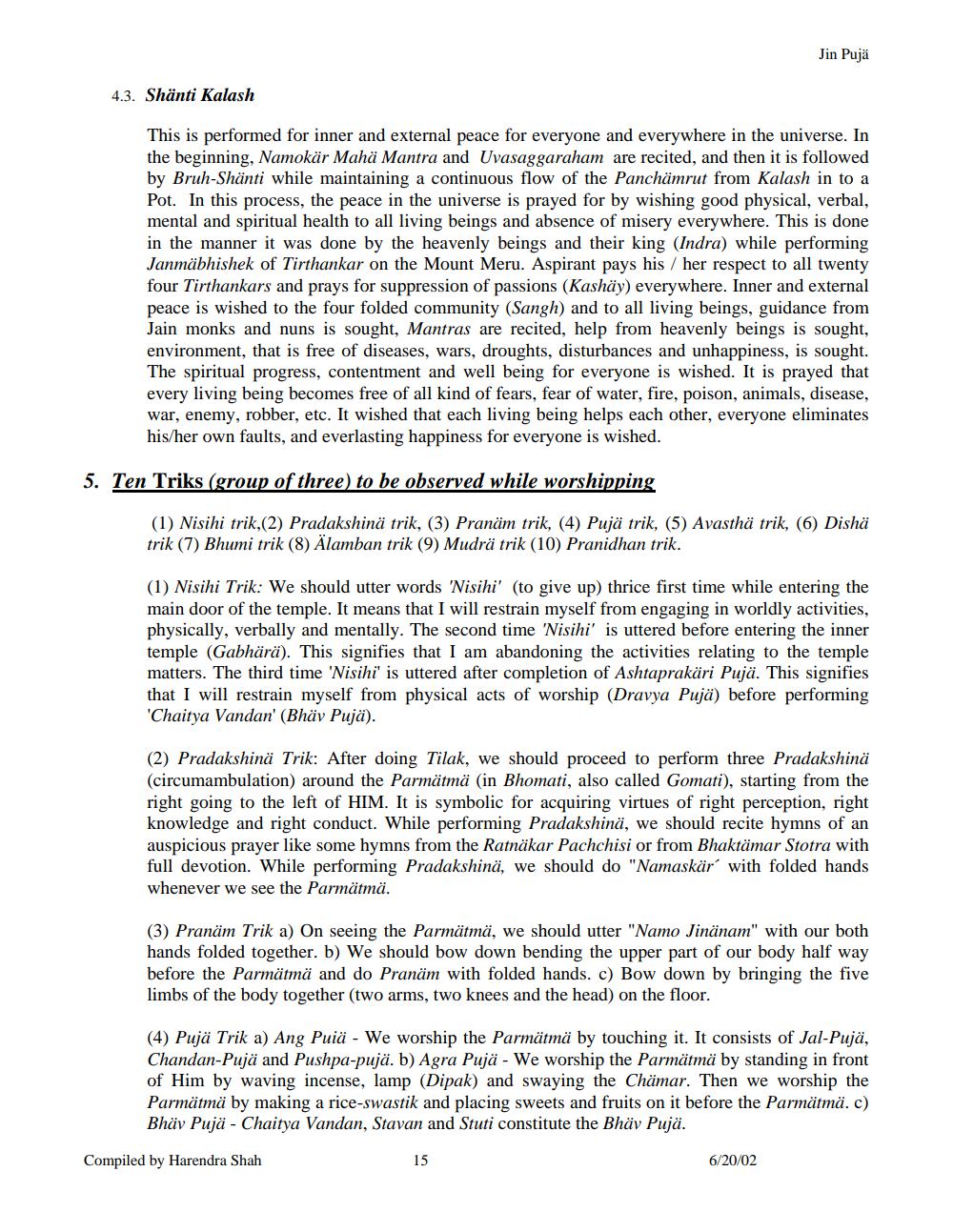________________
Jin Pujä
4.3. Shanti Kalash
This is performed for inner and external peace for everyone and everywhere in the universe. In the beginning, Namokar Mahä Mantra and Uvasaggaraham are recited, and then it is followed by Bruh-Shänti while maintaining a continuous flow of the Panchämrut from Kalash in to a Pot. In this process, the peace in the universe is prayed for by wishing good physical, verbal, mental and spiritual health to all living beings and absence of misery everywhere. This is done in the manner it was done by the heavenly beings and their king (Indra) while performing Janmäbhishek of Tirthankar on the Mount Meru. Aspirant pays his/her respect to all twenty four Tirthankars and prays for suppression of passions (Kashäy) everywhere. Inner and external peace is wished to the four folded community (Sangh) and to all living beings, guidance from Jain monks and nuns is sought, Mantras are recited, help from heavenly beings is sought, environment, that is free of diseases, wars, droughts, disturbances and unhappiness, is sought. The spiritual progress, contentment and well being for everyone is wished. It is prayed that every living being becomes free of all kind of fears, fear of water, fire, poison, animals, disease, war, enemy, robber, etc. It wished that each living being helps each other, everyone eliminates his/her own faults, and everlasting happiness for everyone is wished.
5. Ten Triks (group of three) to be observed while worshipping
(1) Nisihi trik (2) Pradakshinä trik, (3) Pranäm trik, (4) Pujä trik, (5) Avasthä trik, (6) Dishä trik (7) Bhumi trik (8) Alamban trik (9) Mudrä trik (10) Pranidhan trik.
(1) Nisihi Trik: We should utter words 'Nisihi' (to give up) thrice first time while entering the main door of the temple. It means that I will restrain myself from engaging in worldly activities, physically, verbally and mentally. The second time 'Nisihi' is uttered before entering the inner temple (Gabhärä). This signifies that I am abandoning the activities relating to the temple matters. The third time 'Nisihi' is uttered after completion of Ashtaprakäri Pujä. This signifies that I will restrain myself from physical acts of worship (Dravya Pujä) before performing 'Chaitya Vandan' (Bhäv Pujä).
(2) Pradakshinä Trik: After doing Tilak, we should proceed to perform three Pradakshinä (circumambulation) around the Parmätmä (in Bhomati, also called Gomati), starting from the right going to the left of HIM. It is symbolic for acquiring virtues of right perception, right knowledge and right conduct. While performing Pradakshinä, we should recite hymns of an auspicious prayer like some hymns from the Ratnäkar Pachchisi or from Bhaktämar Stotra with full devotion. While performing Pradakshinä, we should do "Namaskär' with folded hands whenever we see the Parmätmä.
(3) Pranäm Trik a) On seeing the Parmätmä, we should utter "Namo Jinänam" with our both hands folded together. b) We should bow down bending the upper part of our body half way before the Parmätmä and do Pranäm with folded hands. c) Bow down by bringing the five limbs of the body together (two arms, two knees and the head) on the floor.
(4) Pujä Trik a) Ang Puiä - We worship the Parmätmä by touching it. It consists of Jal-Pujä, Chandan-Puja and Pushpa-pujä. b) Agra Puja - We worship the Parmätmä by standing in front of Him by waving incense, lamp (Dipak) and swaying the Chämar. Then we worship the Parmätmä by making a rice-swastik and placing sweets and fruits on it before the Parmätmä. c) Bhäv Puja - Chaitya Vandan, Stavan and Stuti constitute the Bhäv Pujä.
Compiled by Harendra Shah
15
6/20/02




